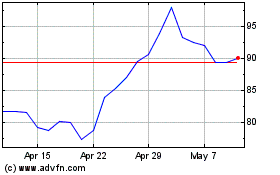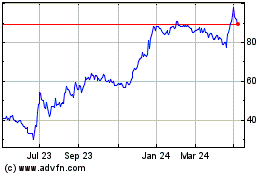CARACAS—Millions of pounds of provisions, stuffed into
three-dozen 747 cargo planes, arrived here from countries around
the world in recent months to service Venezuela's crippled
economy.
But instead of food and medicine, the planes carried another
resource that often runs scarce here: bills of Venezuela's
currency, the bolivar.
The shipments were part of the import of at least five billion
bank notes that President Nicolá s Maduro's administration
authorized over the latter half of 2015 as the government boosts
the supply of the country's increasingly worthless currency,
according to seven people familiar with the deals.
And the Venezuelan government isn't finished. In December, the
central bank began secret negotiations to order 10 billion more
bills, five of these people said, which would effectively double
the amount of cash in circulation. That order alone is well above
the eight billion notes the U.S. Federal Reserve and the European
Central Bank each print annually—dollars and euros that unlike
bolivars are used world-wide.
Four spokesmen from Venezuela's central bank didn't respond to
calls and emails seeking comment.
Economists say the purchases could exacerbate Venezuela's
economic meltdown: injecting large numbers of freshly printed notes
is likely to stoke inflation, which the International Monetary Fund
estimates will this year hit 720%, the world's highest rate.
Central-bank data show Venezuela in 2015 more than doubled
monetary liquidity, a measure used to gauge all money in the
economy, including bank deposits.
Printing more bolivars is weakening the currency further. This
week, the bolivar broke the psychologically important level of
1,000 per dollar for the first time on the country's thriving black
market.
The country has several official exchange rates, including 6.3
bolivars to the dollar. On Wednesday the country's trade and
investment minister, Jesú s Farí a, called for an overhaul of
currency controls. "It's evident that the current currency regime
has exhausted itself," he said in an interview.
Venezuela's 30 million people can't seem to get cash fast
enough, said Steve H. Hanke, an expert on troubled currencies at
Johns Hopkins University. "People want cash because they want to
get rid of it as fast as they can," he said.
While use of credit cards and bank transfers is up, Venezuelans
have to carry stacks of cash as many vendors try to avoid
transaction fees. Dinner at a nice restaurant can cost a brick-size
stack of bills. A cheese-stuffed corn cake—called an arepa—sells
for nearly 1,000 bolivars, requiring 10 bills of the
highest-denomination 100-bolivar bill, each worth less than 10 U.S.
cents.
Rigid state price controls have only made matters worse,
economists say, generating a thriving black market for just about
every good, from car tires to baby diapers, in which cash is the
preferred form of payment.
The bank-note buying spree is costing the cash-strapped leftist
government hundreds of millions of dollars, said all seven of the
people, who have been briefed on the deals Venezuela has entered
with bank-note producers.
The high cost of the printing binge is an especially heavy
burden as Venezuela reels from the oil-price collapse and 17 years
of free-spending socialist rule that have left state finances in
shambles.
Most countries around the world have outsourced bank-note
printing to private companies that can provide sophisticated
anticounterfeiting technologies like watermarks and security
strips. What drives Venezuela's orders is the sheer volume and
urgency of its currency needs.
The central bank's own printing presses in the industrial city
of Maracay don't have enough security paper and metal to print more
than a small portion of the country's bills, the people familiar
with the matter said. Their difficulties stem from the same dollar
shortages that have plagued Venezuela's centralized economy, as the
Maduro administration struggles to pay for imports of everything,
including cancer medication, toilet paper and insect repellent to
battle the mosquito-borne Zika virus.
That means Venezuela has to buy bolivars from abroad at any
cost. "It's easy money for a lot of these companies," one of the
people with details on the negotiations said.
The huge order for 10 billion notes can't be satisfied by any
single printera single firm, the people familiar with the deals
said. So it has generated interest from some of the world's largest
commercial printers, each vying for a piece of the pie at a time
when low profits in bank-note printing have pushed many of them to
cut back on capacity.
According to the people familiar with the deals, the companies
include the U.K.'s De La Rue, the Canadian Bank Note Co., France's
Oberthur Fiduciaire and a subsidiary of Munich-based Giesecke &
Devrient, which printed currency in 1920s Weimar Germany, when
citizens hauled wheelbarrows of cash to buy bread. More recently,
the German technology company was the source of security paper for
Zimbabwe when it was stricken in 2008 with a hyperinflation episode
in which prices doubled daily.
All of the printing firms declined to comment except the
Canadian company, which didn't respond to requests to comment.
Currency experts say the logistical challenges of importing and
storing massive quantities of bank notes underscore an undeniable
truth: Venezuela is spending a lot more than it needs because the
government hasn't printed a higher-denomination bank note—revealing
a misplaced fear, analysts say, that doing so would implicitly
acknowledge high inflation the government publicly denies.
"Big bills do not cause inflation. Big bills are the result of
inflation," said Owen W. Linzmayer, a San Francisco-based bank-note
expert and author who catalogs world currencies. "Larger bills can
actually save money for the central bank because instead of having
to replace 10 deteriorated notes, you only need five or one," he
said.
The Venezuelan central bank's latest orders have been
exclusively only for 100- and 50-bolivar notes, according to the
seven people familiar with the deals, because 20s, 10s, 5s and 2s
are worth less than the production cost.
Mr. Maduro and his allies say galloping consumer prices reflect
a capitalist conspiracy to destabilize the government.
The president in late December changed a law to give himself
full control over the central bank, stripping congressional
oversight just as his political opponents took control of the
National Assembly for the first time in 17 years.
"To stop excessive printing we have to undo that law and restore
autonomy to the central bank," said Elí as Matta, an opposition
lawmaker who focuses on state finances.
Central-bank data shows Venezuela more than doubled the supply
of 100-, 50- and 2-bolivar notes in 2015 as it doubled monetary
liquidity, a measure used to gauge all money in the economy,
including bank deposits. Supply has grown even as Venezuela has
fewer U.S. dollars to support new bolivars, a result of falling oil
prices.
The flood of money has led some sectors of the economy, such as
real estate and car sales, to effectively price their goods in U.S.
dollars, though they do so on the sly because dealing in foreign
currency is illegal. On the crime-ridden streets of Caracas, people
in the security industry say, professional kidnap-and-ransom teams
often demand U.S. currency instead of bolivars.
A color photocopy of a 100-bolivar bill costs more than the
note. In an image that went viral on social media, a diner is shown
using a 2-bolivar note to hold a greasy fried turnover because it
is cheaper than a napkin.
Some ATMs limit withdrawals to around 6,000 bolivars a day—less
than $6 on the unofficial market. Even so, the machines often run
out of cash. And in a sign of how quickly freshly printed bolivars
are rushed into the economy, the serial numbers on crisp bills
dispensed by ATMs are often in sequential order.
What clear is that there is little respect for the beleaguered
bolivar, regardless of what form it takes.
On a recent day, a 46-year-old slum-dweller named Mario walked
the streets of a wealthy district of Caracas with a megaphone,
calling on residents to sell him their coins, which he gathered
into a rolling water cooler. The idea: to melt it down later.
"You can make an amazing ring," said Mario, who wouldn't give
his last name but said he preferred to go by his nickname, Moneda,
or "Coins."
(END) Dow Jones Newswires
February 03, 2016 20:25 ET (01:25 GMT)
Copyright (c) 2016 Dow Jones & Company, Inc.
De La Rue (LSE:DLAR)
Historical Stock Chart
From Mar 2024 to Apr 2024

De La Rue (LSE:DLAR)
Historical Stock Chart
From Apr 2023 to Apr 2024
